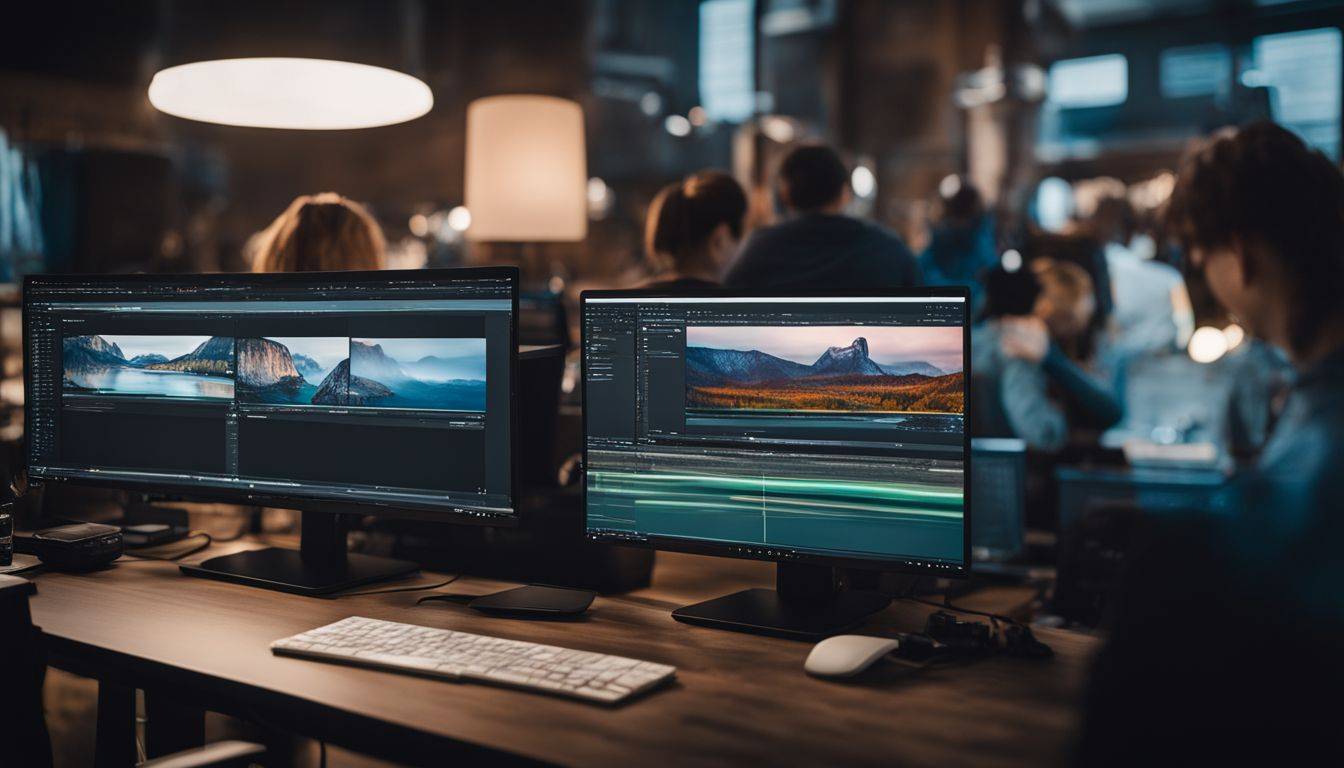Think you found a video but don’t know where it comes from? With the vastness of the internet, pinpointing the exact source can be like finding a needle in a digital haystack. But here’s an insider secret: using reverse video search techniques can help reveal its origins! Dive into this Ultimate Guide to Reverse Video Search and discover how to unlock this powerful tool for tracing videos back to their home turf.
Ready? Let’s get started with your online detective work!
Key Takeaways
- Reverse video search lets you find where a video comes from. You can use tools like Google, Bing, Berify, Shutterstock, TinEye and Yandex Images.
- The tool works by looking at the images and sounds in your chosen video. It then matches these to similar content on the web.
- We should use reverse video search for faster blogging and fair credits. This helps us spot if someone uses our videos without asking.
- To do a reverse search, take a screenshot of your chosen scene from the video. Upload it to one of the sites listed above using their image search box.
What is Reverse Video Search?

Reverse video search is a powerful online tool that allows you to identify the source or origin of a specific video content. It’s highly efficient for locating original videos, detecting plagiarized copies and safeguarding copyrighted materials, offering an invaluable resource for bloggers today.
Definition of reverse video search
Reverse video search lets you find where a video comes from. It uses engines that can look at the parts of a video’s content to learn its source. This tool also helps to check where still frames in a video are from.
Reverse video search is not hard to use and it can help bloggers find the real source for any video they come across.
Reasons to use it
Reverse video search helps you find where a video came from. It is a great tool for bloggers who want to be sure about the source of their content. This tool makes your work easy when looking for related videos.
You can even find videos that look like the one you have.
This tool also lets you see the full video, not just short clips. This can help make your blog posts more accurate and high quality. With reverse video search, image-based searching becomes possible too! That means you don’t always need a name or title to look up a video’s source.
Also, finding out where a certain video came from has other uses. For instance, if there’s an amazing clip in your post but it didn’t come from you, then knowing its real source is important.
Not only does this keep things fair, but it also gives credit where credit is due!
How Does Reverse Video Search Work?

Reverse video search functions through complex algorithms that match image and audio data to identify the source of a video content. It broadens its scope by exploring multiple online platforms, databases, and other resources where such videos might have been shared or published.
Google algorithms and image/audio matching
Google uses special rules called algorithms in reverse video search. These algorithms take a close look at the images and sounds in the video. They help to find where the video comes from and check if its content is true.
These Google algorithms don’t just look at one or two things in a video. They match all parts of an image and any sound that is heard to give you good results. You can trust these results because this method of checking videos is very strong.
Sources it searches
Reverse video search uses smart math rules, called algorithms. These find a match for the images and sounds in the video. The tool checks all parts of the web to find these matches.
This is useful if you want to know where a video came from. It can tell you if it’s real or not and show related content. You can use tools like Google and Yandex for this type of search.
Deep Dive into Reverse Video Search
Reverse video search has power. It lets you find where a video comes from online. This might seem like a fun trick, but it’s more than that. Bloggers can use this tool to learn about videos and images on the web.
Google, TinEye, and Bing give this service for free. They look at pictures and sounds from a video to find matches on the internet. That is how they track down the source of a video; just like finding where someone lives based off their footprint! It’s not magic – it’s all thanks to algorithms doing their work behind the scenes.
Reverse Video Search Methods
In our journey to understand reverse video search, we will explore various methods such as Google’s image matching system, Bing’s robust search functions, Berify’s extensive platform, Shutterstock’s colossal library of videos and images, TinEye’s impressive database, and Yandex Images’ comprehensive search capabilities.
Google is a powerful tool for reverse video search. It digs deep into the web to find similar content. This works by taking a screenshot of any part of the video you want to search.
Next, put this image into Google Images and let it do its work! Google uses special codes called algorithms. These help to spot matching images or sounds from your video in other places on the web.
This method can also help check if a video is real or fake. So, if you have doubts about a clip’s truth, try this step-by-step approach out!
Bing
Bing is a good tool for reverse video search. This process uses special math rules, or algorithms. The system checks images and sounds from the video. Then, it looks on the internet for matches or similar stuff.
You can find where any video comes from with Bing’s help. It’s easy to use for bloggers like you!
Berify
Berify.com is a useful site for reverse video search methods. It can help bloggers find the root of any image or video with ease. Berify digs deep into the web, finding sources you may not see on other sites.
You just need to put in an image or paste a link to start using it.
It’s not just about locating videos and images, though. Berify also aids in protecting your brand from copycats. Its smart tech hunts down copies of your content online. This can help you keep an eye on who’s sharing your stuff without asking first!
Shutterstock
Shutterstock is a strong tool for reverse video search. It works well because it has many videos. Over 200 million assets are in its list! You can use this to find any video’s source.
Its feature called Reverse Search for Video makes this easy. This tool helps bloggers find stock footage fast. So, if you need to do a reverse search, think of Shutterstock.
TinEye
TinEye is a tool you can use for reverse video searches. You get to search a huge library of 61.9 billion images. The way it works is simple: just upload an image or paste its URL in the search bar.
Drag and drop also work if that’s easier for you. This makes TinEye great for performers, researchers, and bloggers who like to find similar videos quickly and easily.
Yandex Images
Yandex Images is a powerful tool you can use for reverse video search work. This tool captures and searches for images all over the web. It supports your blog by finding where else an image has been used.
Yandex Images makes sure you have unique visual content on your site. It’s easy to use and helps stop copycats from stealing your work!
How to Conduct a Reverse Video Search
Delve into our comprehensive step-by-step guide on conducting a successful reverse video search, enhancing brand protection, and identifying duplicate content. Stay tuned to explore these breakthrough techniques further!
Step-by-step guide
Making a reverse video search is easy. Here’s how you can do it:
- Choose the video you want to learn about.
- Take a clear screen capture of an important scene in the video.
- Go to Google’s image search page. It’s like their normal page, but for photos, not words.
- You should see a small camera icon in the search bar.
- Click on this camera icon.
- A new window will open up for you.
- In this window, press ‘Upload an image’.
- Then click ‘Choose file’.
- Pick the screenshot you took earlier from your computer and upload it.
- Now just wait for Google to work its magic.
- In no time, Google will list all matching results.
Tips for successful searches
Start your video search in clear light. Good light helps the app see your video better. Use words linked to the video in your search bar. More details give you more accurate results fast.
This timesaving search technique gets you what you want quickly. Finally, make sure to use a trusted tool like Google Lens on Chrome App for best results in source recognition and content comparison during reverse video searches.
Protecting your brand
You need to keep your brand safe. Reverse video search helps you do this. It finds if someone uses your video without asking. This can harm your unique brand and its reputation. To stop this, use Google reverse video search.
This tool checks where the video comes from. So, keep an eye on your videos and keep them safe!
Using reverse video search for duplicate content
Reverse video search helps find copies of your videos. It finds where else they are on the web. You upload a clip or paste a link into the search box. The tool then scans for matches.
It uses frames, sounds, and details in the video to do this. If it finds matches, you know those are duplicates of your content. This is important if someone steals your work without asking or paying for it.
You can take action to protect your stuff! Also, finding duplicate content can improve how well you made the video in future works.
Conclusion
With the power of reverse video search, finding a video’s source becomes easy. It gives you the tool to catch stolen videos and protect your work. So, dive in! Start using reverse video search to uncover truths about videos online.
